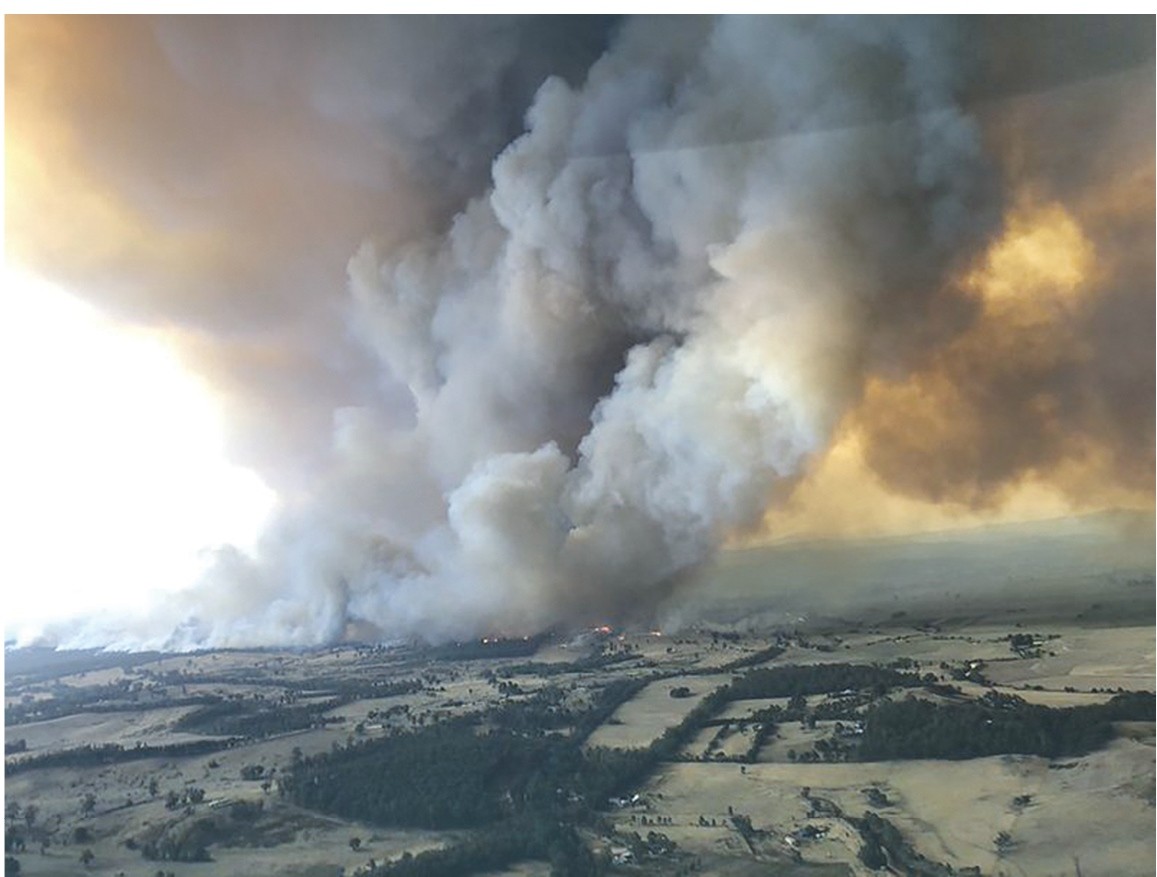Climate factor behind Australia wildfires

By Seth Borenstein
Australia’s unprecedented wildfires are supercharged thanks to climate change, the type of trees catching fire and weather, experts say.
And these fires are so extreme that they are triggering their own thunderstorms.
Here are a few questions and answers about the science behind the Australian wildfires that so far have burned about 5 million hectares (12.35 million acres), killing at least 17 people and destroying more than 1,400 homes.
“They are basically just in a horrific convergence of events,” said Stanford University environmental studies director Chris Field, who chaired an international scientific report on climate change and extreme events. He said this is one of the worst, if not the worst, climate change extreme events he’s seen.
Is climate change really a factor?
Scientists, both those who study fire and those who study climate, say there’s no doubt man-made global warming has been a big part, but not the only part, of the fires.
Last year in Australia was the hottest and driest on record, with the average annual temperature 2.7 degrees Fahrenheit (1.5 degrees Celsius) above the 1960 to 1990 average, according to Australia’s Bureau of Meteorology. Temperatures in Australia last month hit 121.8 F (49.9 C).
“What would have been a bad fire season was made worse by the background drying/warming trend,’’ Andrew Watkins, head of long-range forecasts at Australia’s Bureau of Meteorology, said in an email.
Mike Flannigan, a fire scientist at the University of Alberta in Canada, said Australia’s fires are “an example of climate change.”
How does climate change make these fires worse?
The drier the fuel — trees and plants — the easier it is for fires to start and the hotter and nastier they get, Flannigan said.
“It means more fuel is available to burn, which means higher intensity fires, which makes it more difficult — or impossible — to put out,” Flannigan said.
The heat makes the fuel drier, so they combine for something called fire weather. And that determines “fuel moisture,” which is crucial for fire spread. The lower the moisture, the more likely Australian fires start and spread from lightning and human-caused ignition, a 2016 study found.
There’s been a 10% long-term drying trend in Australia’s southeast and 15% long-term drying trend in the country’s southwest, Watkins said. When added to a degree of warming and a generally southward shift of weather systems, that means a generally drier landscape.
Has Australia’s fire season changed?
Yes. It’s about two to four months longer, starting earlier especially in the south and east, Watkins said.
“The fires over the last three months are unprecedented in their timing and severity, started earlier in spring and covered a wider area across many parts of Australia,” said David Karoly, leader of climate change hub at Australia’s National Environmental science Program. “The normal peak fire season is later in summer and we are yet to have that.”
Is weather, not just long term climate, a factor?
Yes. In September, Antarctica’s sudden stratospheric warming — sort of the southern equivalent of the polar vortex — changed weather conditions so that Australia’s normal weather systems are farther north than usual, Watkins said.
That means since mid-October there were persistent strong westerly winds bringing hot dry air from the interior to the coast, making the fire weather even riskier for the coasts.
“With such a dry environment, many fires were started by dry lightning events (storms that brought lightning but limited rainfall),” Watkins said.
Are people starting these fires? Is it arson?
It’s too early to tell the precise cause of ignition because the fires are so recent and officials are spending time fighting them, Flannigan said.
While people are a big factor in causing fires in Australia, it’s usually accidental, from cars and trucks and power lines, Flannigan said. Usually discarded cigarettes don’t trigger big fires, but when conditions are so dry, they can, he said.
Are these fires triggering thunderstorms?
Yes. It’s an explosive storm called pyrocumulonimbus and it can inject particles as high as 10 miles into the air.
During a fire, heat and moisture from the plants are released, even when the fuel is relatively dry. Warm air is less dense than cold air so it rises, releasing the moisture and forming a cloud that lifts and ends up a thunderstorm started by fire. It happens from time to time in Australia and other parts of the world, including Canada, Flannigan said.“These can be deadly, dangerous, erratic and unpredictable,” he said.
Are the Australian trees more prone to burning?
Eucalyptus trees are especially flammable, “like gasoline on a tree,” Flannigan said. Chemicals in them make them catch fire easier, spread to the tops of trees and get more intense. Eucalyptus trees were a big factor in 2017 fires in Portugal that killed 66 people, he said.
Associated Press
Recent News

Do not make expressions casting dout on election: EC
14 Apr, 2022
CM Bhatta says may New Year 2079 BS inspire positive thinking
14 Apr, 2022
Three new cases, 44 recoveries in 24 hours
14 Apr, 2022
689 climbers of 84 teams so far acquire permits for climbing various peaks this spring season
14 Apr, 2022
How the rising cost of living crisis is impacting Nepal
14 Apr, 2022
US military confirms an interstellar meteor collided with Earth
14 Apr, 2022
Valneva Covid vaccine approved for use in UK
14 Apr, 2022
Chair Prachanda highlights need of unity among Maoist, Communist forces
14 Apr, 2022
Ranbir Kapoor and Alia Bhatt: Bollywood toasts star couple on wedding
14 Apr, 2022
President Bhandari confers decorations (Photo Feature)
14 Apr, 2022











